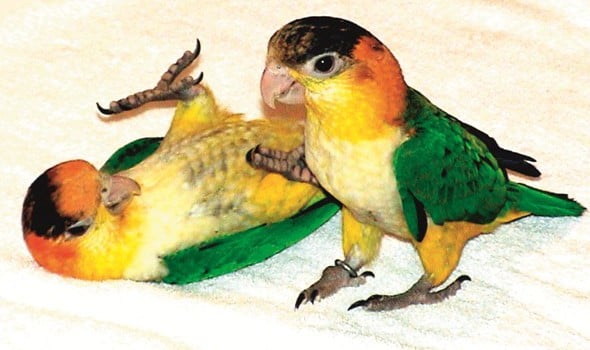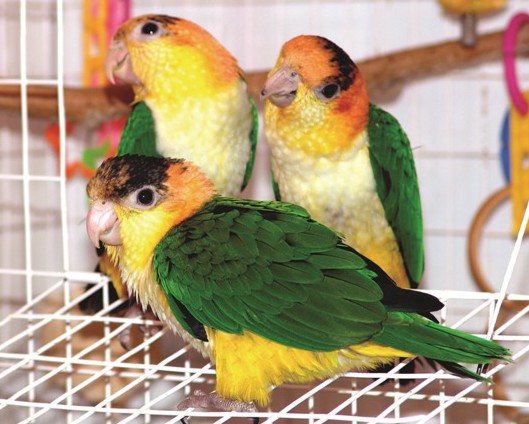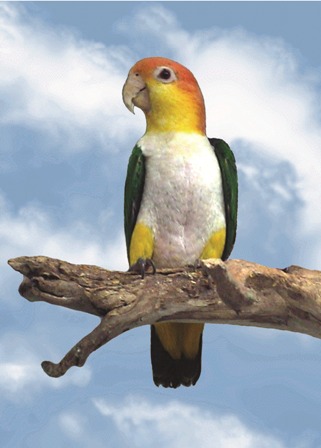
Species Profile White-bellied Caiques
Caiques, Black-headed or White-bellied, are exceptional parrots. Their curious, comical nature is captivating, sociable yet extraverted and definitely independent. They require a spacious cage, with many things to shred and tear to bits; it is the price to pay to have a bird well suited in his feathers, sane and healthy. Caiques are resistant birds that do not fear cooler temperatures, they do not require particular care, other than those that ensure good hygiene, a healthy nutrition and lots of physical activity.
Caique Behavior
 Young caiques soon gain their reputation as comical gesticulate clowns; always eager to climb out of their baby pens and soon out of their weaning cages. They initiate game by chasing balls, throwing about their feeding spoons, bouncing about like kangaroos. In their cages, they can often be found in the bottom; lying on their backs playing with a toy or grape in their beaks…One must always be vigilant with a caique for they fear nothing and are out and about at any given moment. Unlike many other avian companions they manifest no hesitation when presented with a new toy, their insatiable sense of curiosity can have them pursue a desired object into an open drawer, or have them plunge under a running faucet for a shower…even when the water is hot! They must never be left unguarded; let us not forget the cooking pans on the stove, simmering sauce pans, dirty soapy water pals and all the other unimaginable potential household dangers. To prevent accidents, constant supervision is essential when these youngsters are out of their cages.
Young caiques soon gain their reputation as comical gesticulate clowns; always eager to climb out of their baby pens and soon out of their weaning cages. They initiate game by chasing balls, throwing about their feeding spoons, bouncing about like kangaroos. In their cages, they can often be found in the bottom; lying on their backs playing with a toy or grape in their beaks…One must always be vigilant with a caique for they fear nothing and are out and about at any given moment. Unlike many other avian companions they manifest no hesitation when presented with a new toy, their insatiable sense of curiosity can have them pursue a desired object into an open drawer, or have them plunge under a running faucet for a shower…even when the water is hot! They must never be left unguarded; let us not forget the cooking pans on the stove, simmering sauce pans, dirty soapy water pals and all the other unimaginable potential household dangers. To prevent accidents, constant supervision is essential when these youngsters are out of their cages.
We often refer to caiques as being hyperactive, and that is an understatement. I can recollect one particular moment that I saw a caique exhausted and eager to regain his cage. It was upon our return from a bird exposition, where he had spent 2 days amongst a dense crowd, an exhausting background noise and vibrant lights.
Caiques are always ready for game and exploration. As a mere stimulus can spark their excitement, playful interactions and games can often turn into a ferocious competition. We must be careful not to encourage this extreme state of excitement when engaging in game with our companions. Like children over-whelmed by their game ending up in fight; caiques can become aggressive, bite and shed blood. It is imperative to learn to bring back calmness to an overly excited state, by speaking softly, by toning down the gestures and subtlety offering an alternative imperturbable activity.
It is absolutely indispensable to structure caiques at the earliest age. Uneducated, the fledgling will soon conquer his territory, establish his limits and impose his laws, which is certainly undesirable, especially critical for he will soon reach adolescence. Limits must be reinforced with gentleness, patience and perseverance. As they are intelligent little creatures, they will immediately perceive that you are imposing a limit, defiant he might challenge your authority by biting. It is difficult to impose a behavior onto a Caique, thus it is best to try to deviate its intentions, bring about a distraction, regain a sense of calmness and gradually we can lure him to obedience.
Regardless of the Caiques’ nature to seek human interaction and companionship, they are independent parrots, which means that they do not necessarily desire to be caressed or fondled. The mere pleasure of being in the presence of his companion, in the same room, atop his play gym, within distance of your voice and arm is often enough to satisfy his need for affection. Contrary to Sun Conures, who cuddle against you, crawl into your shirt and embrace you with kisses, like our feline companions, Caiques are more distant. Beware to impose your physical manifest of affection onto them when they do not desire it… Although, there are absolutely magical moments when a Caique will indulgently caress his body against yours, nestle himself in your hair, will rest on his back on your knees and accept to be pet. This behavior is not necessarily of sexual nature, since we have experienced this with our youngsters as well.
Caique Level and Frequency of Screaming and Vocalizing
It is always difficult to talk about the degree of noise that each perceive depending on their level of tolerance. Certain people will complain about the level of vocalization of cockatiels as well as the incessant chattering of budgies. I have even heard of someone who was annoyed by the chirping of finches… Caiques are not particularly noisy; their morning and sundown vocalizations are of short duration and tolerable. Their screams resemble a door screech or a whistling kettle, which can reach intensity and become irritable, especially if the bird feels threatened or tired. We know that parrots vocalize in the wild to communicate, locate and warn others of their species; in our homes, these cries can soon become annoying, without saying maddening. As Caiques know how to find occupational activities within their enclosures when provided toys, branches and objects to peek their curiosity, and because they are not malady dependant on their human companions, they are amongst the least noisiest parrot companion species. When a caique streaks insistently, there is usually something bothering him in his environment, which he feels threatened by. I recommend going to see immediately what could be causing this commotion. It took me close to one hour to unveil what was provoking alarm screams from Micky, supported also by his cage mate Angie: an insect had crawled out from a bag of seeds and was flying about their flight cage; when I finally captured this beast, everyone regained their collected state.
Caiques are not good talkers: they imitate quite well repetitive noises heard in their home, telephone, microwave, but are not so inclined to use the human language. My young male (now 3 yrs old) says his name very clearly, with a cartoon character voice, repeating three times «Micky, Micky, Micky» when he wants to come out of his cage. No one taught him this; he learned by himself to repeat his name that we would use every time we would speak to him. Our three other caiques converse with their South American language that I still try to understand.
 White-bellied Caique Male/Female Differences
White-bellied Caique Male/Female Differences
There is no visual sexual dimorphism between the male and female Caique; a DNA test is required to ensure the proper sex determination of this species. Breeders can determine the sex of the bird based on their behavior, but its judgement can be misinterpreted for there are exceptions in individuals. Generally, the male is more aggressive than the female which tend to be more timid. In the wild, the male exhibits more aggressively, necessary to protect the pair’s nest, chicks and mate, he must be watchful and vigilant.
Our oldest couple is a contradiction to this rule: Kiko is a gentile male, slightly distraught and submissive to his female, Kalinka. She on the other hand conducts herself often like a male; she is the one who comes out of the cage first, who feeds at the feeder of her choice first, often chasing Kiko in their cage. Kiko has never bitten any of us since they have been under our guardianship. Even during excited levels of activity; Kalinka has without doubt demonstrated her biting abilities with conviction, without warning, to each and every one of us. She has gone through periods where her behavior was so unpredictable, that avoiding her rage of aggressiveness became a challenge. We would watchfully observe her eyes, and attitude; trying in vain to slow down the excess of energy hoping to prevent the inevitable bites. Despite our brave efforts we would finally have to use Hibitane and Band-Aids for our fingers. Fortunately, gradually her excess of aggressivity diminished. Since she has experienced «motherhood», Kalinka seems to have softened her behavior, towards her mate Kiko as well.
My second pair, which is now 3 years old exhibits behavior that is more representative of this species. Micky, a macho male, takes all initiatives, engages the interactions, explores, solicits and leads Angie, his mate to abide by his commands. Angie is more timid, hesitant and will touch an unfamiliar object, or enter in an unknown territory only once Micky has surveyed it first. Micky has developed an animosity towards my husband; he has chosen me as his second mate. The privileges manifested by this claim are demonstrated by Micky, following me wherever I go, he leans onto and rolls on my cloths, burrows in my shirt, will lay in my hand while showering under the faucet, and will allow me to return him to his flight without resistance when the game is over.
When our four Caiques gather in the kitchen, they interact as a lovely flock of small parrots; they fly, chatter and playfully chase one another without aggressivity. They were housed in the same breeding room for more than two years, visiting each other’s flights and feeding stations, exchanging vocalizations that older Caiques share with youngsters and vice versa. This cohabitation possibly halted the desire to reproduce for Kiko and Kalinka. We were driven to separate the pairs so that the miracle could happen…
Nutrition for White-bellied Caiques
Caiques have a good appetite, and feast on a varied diet. My pairs were probably weaned on an abundance of variety as well for they savour a diversity of fruits, veggies, beans, granules and seeds. Sally Blanchard has said…. “what is nutritionally important is not only what is offered, but what is consumed and especially what is metabolized by the body”.
If I evaluate my pairs, their dietary needs are met: they are athletic and muscular, have irreproachable plumage, beaks and well groomed nails, alert eyes and prompt reflexes. The formulated pelleted diet is always present in their cage in abundance: granules and Tropimix Parrot Low Fat Bean Mix, as well as one spoon of Cartame Seeds. To supplement this diet, everyday they are offered a freshly cut mixed vegetables macédoine, my recipe of cooked brown rice and quinoa and a brochette of fresh fruits. Occasionally they are offered boiled chicken bone and meat, a little fish, low fat cottage cheese. For activity whilst feasting, I offer a branch of celery, a carrot with top, a squash, spinach leaves, dandelions, rappini, heart of mild pepper, etc. For dessert, when I leave the room, I treat them with a walnut or almond (or 3 cashew with shell). Every bird awaits this treat and will then allow me to leave the room without too much objection.
Caiques and Children
(This is a frequently asked question when adopting a species or another). Do Caiques interact well with children? Before the age of hormonal awakening (adolescence), Caiques, like many other parrots in captivity like to interact with children whose level of energy resembles its own: lots of game, cries of excitement, laughter and unconditional attention. But beware, as soon as the hormones invade their system, Caiques become unpredictable and their behavior can spontaneously change. Although it appeared content to play with the child, without warning he attacks the approaching hand to bite it painfully. We should never allow a young child to play with a Caique that has not learned to decode the posture of the bird. In the phase of excitement during game playing, a gesture can provoke an aggressive reaction from a bird that he will not even understand.
A Caique needs to recognize in his counterpart a certain dose of assurance; it sees in a child one that can be dominated. If the adult has established a relationship based on confidence with his Caique, based on a firm discipline with limiting constraints, supervises the game between a child and bird, he will be able to prevent sudden attacks.
Learn to understand your Caique, decode its body language, evaluate his degree of excitability, respect its profound nature, immutable of a creature still wild at heart, barely domesticated that must adapt to a captive life that often surpasses its own reason. It is the only way to establish a harmonious relationship for possibly the next 30 years of companionship.
Article and photography By: Danielle Odulinski


